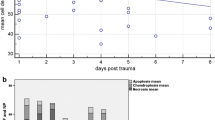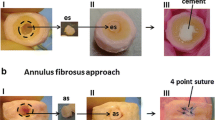Abstract
There is a major controversy whether spinal trauma with vertebral endplate fractures can result in post-traumatic disc degeneration. Intervertebral discs, which are adjacent to burst endplates, are frequently removed and an intercorporal spondylodesis is performed. In any case, the biological effects within the discs following endplate factures are poorly elucidated to date. The aim of our investigations was therefore to establish a novel disc/endplate trauma culture model to reproducibly induce endplate fractures and investigate concurrent disc changes in vitro. This model is based on a full-organ disc/endplate culture system, which has been validated by the authors before. Intervertebral disc/endplate specimens were isolated from Burgundy rabbits and cultured in standard media (DMEM/F12, 10%FCS). Burst endplate fractures were induced in half of the specimens with a custom-made fracture device and subsequently cultured for 9 days. The biological effects such as necrotic or apoptotic cell death and the expression of pro-apoptotic genes and other genes involved in organ degeneration, e.g. matrix metalloproteinases (MMPs) were analyzed. Cell damage was assessed by quantification of the lactate dehydrogenase (LDH) activity in the supernatant. The expression of genes involved in the cellular apoptotic pathway (caspase 3) and the pro-apoptotic proteins FasL and TNF-α were monitored. The results demonstrate that LDH levels increased significantly post trauma compared to the control and remained elevated for 3 days. Furthermore, a constant up-regulation of the caspase 3 gene in both disc compartments was present. The pro-apoptotic proteins FasL and TNF-α were up regulated predominantly in the nucleus whereas the MMP-1 and -13 transcripts (collagenases) were increased in both disc structures. From this study we can conclude that endplate burst fractures result in both necrotic and apoptotic cell death in nucleus and annulus tissue. Moreover, FasL and TNF-α expression by nucleus cells may lead to continued apoptosis induced by Fas- and TNF-α receptor bearing cells. In addition TNF-α over-expression has potentially deleterious effects on disc metabolism such as over-expression of matrix proteinases. Taken together, the short term biological response of the disc following endplate fracture exhibits characteristics, which may initiate the degeneration of the organ.






Similar content being viewed by others
References
Aebi M (2005) The adult scoliosis. Eur Spine J 14:925–948
Ahsan R, Tajima N, Chosa E, Sugamata M, Sumida M, Hamada M (2001) Biochemical and morphological changes in herniated human intervertebral disc. J Orthop Sci 6:510–518
Alanay A (2000) Re: post-traumatic findings of the spine after earlier vertebral fracture in young patients. Spine 25:2847–2848
Anderson DG, Izzo MW, Hall DJ, Vaccaro AR, Hilibrand A, Arnold W, Tuan RS, Albert TJ (2002) Comparative gene expression profiling of normal and degenerative discs: analysis of a rabbit annular laceration model. Spine 27:1291–1296
Bradford MM (1976) A rapid and sensitive method for the quantitation of microgram quantities of protein utilizing the principle of protein–dye binding. Anal Biochem 72:248–254
Bush PG, Hodkinson PD, Hamilton GL, Hall AC (2005) Viability and volume of in situ bovine articular chondrocytes-changes following a single impact and effects of medium osmolarity. Osteoarthritis Cartilage 13:54–65
Chang JK, Wu SC, Wang GJ, Cho MH, Ho ML (2006) Effects of non-steroidal anti-inflammatory drugs on cell proliferation and death in cultured epiphyseal-articular chondrocytes of fetal rats. Toxicology 228:111–123
Chen B, Fellenberg J, Wang H, Carstens C, Richter W (2005) Occurrence and regional distribution of apoptosis in scoliotic discs. Spine 30:519–524
Cinotti G, Della Rocca C, Romeo S, Vittur F, Toffanin R, Trasimeni G (2005) Degenerative changes of porcine intervertebral disc induced by vertebral endplate injuries. Spine 30:174–180
Cohen GM (1997) Caspases: the executioners of apoptosis. Biochem J 326(Pt 1):1–16
Dang AC, Warren AP, Kim HT (2006) Beneficial effects of intra-articular caspase inhibition therapy following osteochondral injury. Osteoarthritis Cartilage 14:526–532
Decker T, Lohmann-Matthes ML (1988) A quick and simple method for the quantitation of lactate dehydrogenase release in measurements of cellular cytotoxicity and tumor necrosis factor (TNF) activity. J Immunol Methods 115:61–69
Dickson RA, Butt WP (2003) Post-traumatic findings of the spine after earlier vertebral fractures in young patients. Spine 28:1749–1750 author reply 1750
D’Lima DD, Hashimoto S, Chen PC, Colwell CW Jr., Lotz MK (2001) Human chondrocyte apoptosis in response to mechanical injury. Osteoarthritis Cartilage 9:712–719
Galante JO (1967) Tensile properties of the human lumbar annulus fibrosus. Acta Orthop Scand Suppl 100:101–191
Goldberg GI, Wilhelm SM, Kronberger A, Bauer EA, Grant GA, Eisen AZ (1986) Human fibroblast collagenase. Complete primary structure and homology to an oncogene transformation-induced rat protein. J Biol Chem 261:6600–6605
Grasl-Kraupp B, Ruttkay-Nedecky B, Koudelka H, Bukowska K, Bursch W, Schulte-Hermann R (1995) In situ detection of fragmented DNA (TUNEL assay) fails to discriminate among apoptosis, necrosis, and autolytic cell death: a cautionary note. Hepatology 21:1465–1468
Guehring T, Omlor GW, Lorenz H, Bertram H, Steck E, Richter W, Carstens C, Kroeber M (2005) Stimulation of gene expression and loss of anular architecture caused by experimental disc degeneration—an in vivo animal study. Spine 30:2510–2515
Haschtmann D, Stoyanov JV, Ettinger L, Nolte LP, Ferguson SJ (2006) Establishment of a novel intervertebral disc/endplate culture model: analysis of an ex vivo in vitro whole-organ rabbit culture system. Spine 31:2918–2925
Haschtmann D, Stoyanov JV, Ferguson SJ (2006) Influence of diurnal hyperosmotic loading on the metabolism and matrix gene expression of a whole-organ intervertebral disc model. J Orthop Res 24:1957–1966
Heyde CE, Tschoeke SK, Hellmuth M, Hostmann A, Ertel W, Oberholzer A (2006) Trauma induces apoptosis in human thoracolumbar intervertebral discs. BMC Clin Pathol 6:5
Holm S, Holm AK, Ekstrom L, Karladani A, Hansson T (2004) Experimental disc degeneration due to endplate injury. J Spinal Disord Tech 17:64–71
Hsu K, Zucherman J, Shea W, Kaiser J, White A, Schofferman J, Amelon C (1990) High lumbar disc degeneration. Incidence and etiology. Spine 15:679–682
Huser CA, Davies ME (2006) Validation of an in vitro single-impact load model of the initiation of osteoarthritis-like changes in articular cartilage. J Orthop Res 24:725–732
Huser CA, Peacock M, Davies ME (2006) Inhibition of caspase-9 reduces chondrocyte apoptosis and proteoglycan loss following mechanical trauma. Osteoarthritis Cartilage 14:1002–1010
Izambert O, Mitton D, Thourot M, Lavaste F (2003) Dynamic stiffness and damping of human intervertebral disc using axial oscillatory displacement under a free mass system. Eur Spine J 12:562–566
Kato T, Haro H, Komori H, Shinomiya K (2004) Sequential dynamics of inflammatory cytokine, angiogenesis inducing factor and matrix degrading enzymes during spontaneous resorption of the herniated disc. J Orthop Res 22:895–900
Kerttula LI, Serlo WS, Tervonen OA, Paakko EL, Vanharanta HV (2000) Post-traumatic findings of the spine after earlier vertebral fracture in young patients: clinical and MRI study. Spine 25:1104–1108
Kifune M, Panjabi MM, Arand M, Liu W (1995) Fracture pattern and instability of thoracolumbar injuries. Eur Spine J 4:98–103
Knauper V, Lopez-Otin C, Smith B, Knight G, Murphy G (1996) Biochemical characterization of human collagenase-3. J Biol Chem 271:1544–1550
Kohyama K, Saura R, Doita M, Mizuno K (2000) Intervertebral disc cell apoptosis by nitric oxide: biological understanding of intervertebral disc degeneration. Kobe J Med Sci 46:283–295
Korzeniewski C, Callewaert DM (1983) An enzyme-release assay for natural cytotoxicity. J Immunol Methods 64:313–320
Kroeber MW, Unglaub F, Wang H, Schmid C, Thomsen M, Nerlich A, Richter W (2002) New in vivo animal model to create intervertebral disc degeneration and to investigate the effects of therapeutic strategies to stimulate disc regeneration. Spine 27:2684–2690
Le Maitre CL, Freemont AJ, Hoyland JA (2004) Localization of degradative enzymes and their inhibitors in the degenerate human intervertebral disc. J Pathol 204:47–54
LeBlanc AC (2003) Natural cellular inhibitors of caspases. Prog Neuropsychopharmacol Biol Psychiatry 27:215–229
Lotz JC, Chin JR (2000) Intervertebral disc cell death is dependent on the magnitude and duration of spinal loading. Spine 25:1477–1483
Mesner PW Jr, Kaufmann SH (1997) Methods utilized in the study of apoptosis. Adv Pharmacol 41:57–87
Morgunova E, Tuuttila A, Bergmann U, Isupov M, Lindqvist Y, Schneider G, Tryggvason K (1999) Structure of human pro-matrix metalloproteinase-2: activation mechanism revealed. Science 284:1667–1670
O’Brien MC, Healy SF Jr, Raney SR, Hurst JM, Avner B, Hanly A, Mies C, Freeman JW, Snow C, Koester SK, Bolton WE (1997) Discrimination of late apoptotic/necrotic cells (type III) by flow cytometry in solid tumors. Cytometry 28:81–89
Omlor GW, Lorenz H, Engelleiter K, Richter W, Carstens C, Kroeber MW, Guehring T (2006) Changes in gene expression and protein distribution at different stages of mechanically induced disc degeneration–an in vivo study on the New Zealand white rabbit. J Orthop Res 24:385–392
Oner FC, van der Rijt RR, Ramos LM, Dhert WJ, Verbout AJ (1998) Changes in the disc space after fractures of the thoracolumbar spine. J Bone Joint Surg Br 80:833–839
Poole CA, Brookes NH, Clover GM (1993) Keratocyte networks visualised in the living cornea using vital dyes. J Cell Sci 106(Pt 2):685–691
Porter AG, Janicke RU (1999) Emerging roles of caspase-3 in apoptosis. Cell Death Differ 6:99–104
Przybyla A, Pollintine P, Bedzinski R, Adams MA (2006) Outer annulus tears have less effect than endplate fracture on stress distributions inside intervertebral discs: relevance to disc degeneration. Clin Biomech (Bristol, Avon) 21(10):1013–1019
Rannou F, Lee TS, Zhou RH, Chin J, Lotz JC, Mayoux-Benhamou MA, Barbet JP, Chevrot A, Shyy JY (2004) Intervertebral disc degeneration: the role of the mitochondrial pathway in annulus fibrosus cell apoptosis induced by overload. Am J Pathol 164:915–924
Seguin CA, Pilliar RM, Roughley PJ, Kandel RA (2005) Tumor necrosis factor-alpha modulates matrix production and catabolism in nucleus pulposus tissue. Spine 30:1940–1948
Sobajima S, Shimer AL, Chadderdon RC, Kompel JF, Kim JS, Gilbertson LG, Kang JD (2005) Quantitative analysis of gene expression in a rabbit model of intervertebral disc degeneration by real-time polymerase chain reaction. Spine J 5:14–23
Takada T, Nishida K, Doita M, Kurosaka M (2002) Fas ligand exists on intervertebral disc cells: a potential molecular mechanism for immune privilege of the disc. Spine 27:1526–1530
Tryggvason K, Huhtala P, Hoyhtya M, Hujanen E, Hurskainen T (1992) 70 K type IV collagenase (gelatinase). Matrix Suppl 1:45–50
Vornanen M, Bostman O, Keto P, Myllynen P (1993) The integrity of intervertebral disks after operative treatment of thoracolumbar fractures. Clin Orthop Relat Res December(297):150–154
Weiler C, Nerlich AG, Zipperer J, Bachmeier BE, Boos N (2002) 2002 SSE Award competition in basic science: expression of major matrix metalloproteinases is associated with intervertebral disc degradation and resorption. Eur Spine J 11:308–320
Whiteside RA, Jakob RP, Wyss UP, Mainil-Varlet P (2005) Impact loading of articular cartilage during transplantation of osteochondral autograft. J Bone Joint Surg Br 87:1285–1291
Yong-Hing K, Kirkaldy-Willis WH (1983) The pathophysiology of degenerative disease of the lumbar spine. Orthop Clin North Am 14:491–504
Acknowledgments
The authors thank the AO Foundation, Davos Switzerland for funding and Ladina Ettinger for excellent technical assistance
Author information
Authors and Affiliations
Corresponding author
Rights and permissions
About this article
Cite this article
Haschtmann, D., Stoyanov, J.V., Gédet, P. et al. Vertebral endplate trauma induces disc cell apoptosis and promotes organ degeneration in vitro. Eur Spine J 17, 289–299 (2008). https://doi.org/10.1007/s00586-007-0509-5
Received:
Revised:
Accepted:
Published:
Issue Date:
DOI: https://doi.org/10.1007/s00586-007-0509-5




